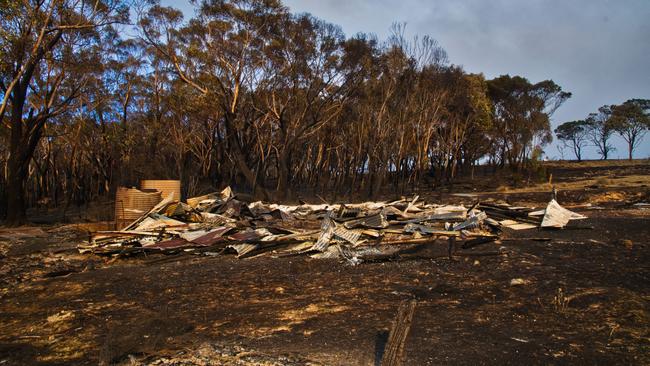AT 9am, a crowd of Rural Fire Service volunteers in yellow overalls assembles at the Taralga fire station north of Goulburn.
A large, mounted map is brought out, marked with red lines showing where their enemy awaits — the fire is now northeast of the town up toward the Mares Forest Road — and black arrows indicate the battle zone.
Co-ordinated forces on the ground — firefighters, trucks (53 of them) and three bulldozers — will combine with aerial attacks. Five helicopters are refuelling in the paddock over the road and three fixed-wing water-bombers are coming from Goulburn.
The idea is to contain the fire, which has already burnt out close to 3000 hectares of bush around the town since it began nine days ago.
There will be a front to the north and a second to the east, the bulldozers carving firebreaks around properties in the same way American pioneers would form their wagons in a circle.
There’s a feeling of unease about where they’re all headed today. “It’s mongrel country out there,” warns volunteer fireman Matt Stevenson.
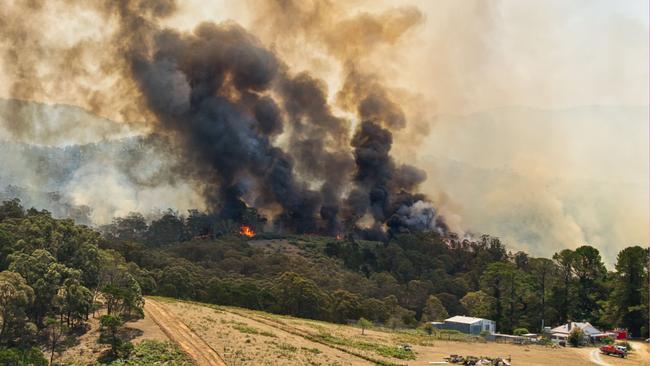
He’s not wrong. The country out Bannaby way is heartbreaking — countless square kilometres of broken, rocky, timber-covered high country that suddenly reveals breathtaking escarpments plummeting into a labyrinth of gullies and creeks. This maze of twisted ravines often doubles back on itself. It’s no place to become disoriented, especially in a firestorm.
For many small country towns, bushfire season is a time when just a whiff of smoke will stop people in their tracks. It’s a time when communities, through years of experience, rally to prevent a bad situation from becoming disastrous. And it is a major operation.
The fire is a cruel, indiscriminate enemy that can turn killer before anyone realises. Embers drifting above the landscape hit the dry foliage like incendiary bombs. Local fireman Greg Keith says of the spotfires that flared up on the edge of town: “It was touch and go on the weekend.”

During the blistering heat last Saturday, from our property north of Goulburn we could see a strange column of smoke emerging on the horizon — black and brown and white, appearing almost atomic as it unfurled, then taking the shape of Goulburn’s famous Big Merino, horns and all.
There was no doubt it was coming from Taralga, a place so dear to us. Ten years ago we bought the ruins of the town’s original stone bakery next to the fire station and rebuilt it. Eventually we moved permanently to a property not far away and enrolled my son at Taralga Public School.
Taralga is what the English would call a hamlet. This rustic village is set among rolling hills on top of the Great Dividing Range in the Southern Tablelands. It’s about 40km north of Goulburn on a wonderful driving road that connects to Oberon. The tiny town boasts a host of historic basalt buildings, two pubs and a bowling club. It’s merino and Black Angus cattle country, as quintessentially Australian as you can get.
Radio reports that day described the fire as being in the Bannaby area, to Taralga’s east along Bannaby Road.
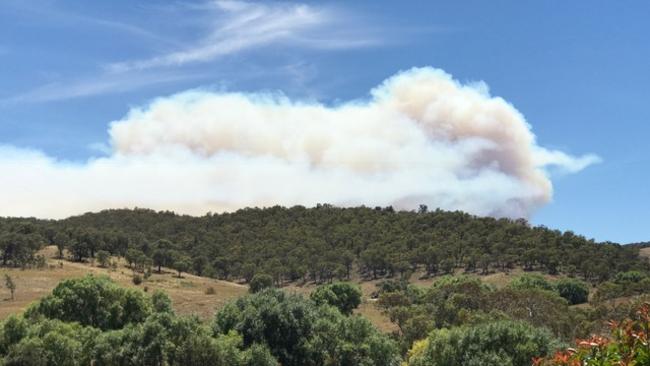
No one is sure what started it. Lightning probably.
The Rural Fire Service categorised it as out of control.
There’s no town at Bannaby, only a few farms and humpies plus an ocean of bush that had become as brittle and as dry as parchment over the summer months. Like everyone else in the district, we feared the worst.
Unlike the city, the weather in Taralga dictates everything. To anyone unaccustomed to the region, conditions here are best described as full-on. When the seasons change, it’s as if a switch has been thrown.
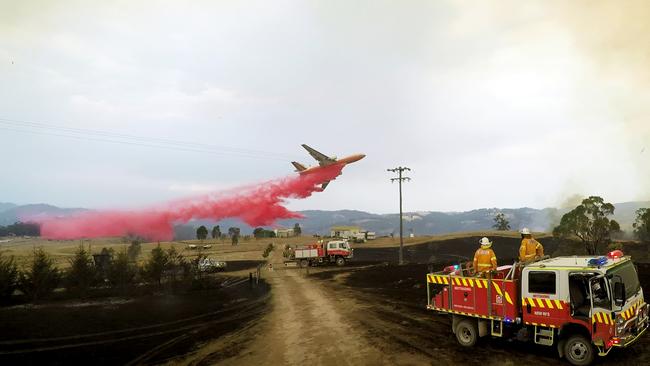
To describe a Taralga winter simply as freezing is an understatement. Winter here is bitter and relentless. The cold is inescapable and will strike you to the bone. Taralga is 845m above sea level and in winter, howling high winds, snow and sleet are a harsh, everyday reality.
But Taralga summers are something else. Humidity here is unknown. Because of the altitude and clear air, the sun becomes a blowtorch and the main street a blast furnace. The UV threat is off the scale and the air so dry, so hot, it burns your nostrils every time you inhale.
It’s several days since the fire broke out and I head into town as the sun begins to emerge. The fire service website still says the fire is out of control and I’m not sure what to expect. The road ahead is shrouded in a dirty, mustard-coloured fog. In the distance I can make out the towers of the Bannaby wind farm — tall, skeletal, the blades like scythes.
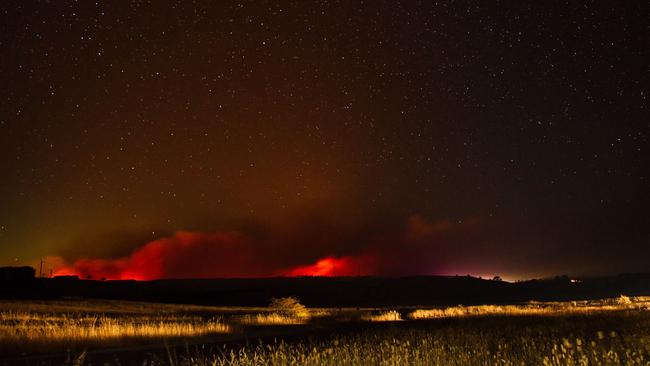
Taralga itself looks like it’s under wartime occupation.
The once sleepy fire station is now general headquarters, swamped with scores of weary, volunteer firefighters picking up coffee from the Salvation Army, the gunbarrel-straight main street lined with columns of fire trucks bearing the names of places I’ve never heard — Cawdor, Orangeville-Werombi, Wallaroo, Grabben Gullen.
A familiar face appears in the crowd. It’s Bill Wilkes from the Middle Arm-Wayo brigade, just finishing a long, overnight shift. He looks exhausted.
I shake his hand and he smiles. Bill’s an old bushie and his grey beard and kind eyes are ingrained in my memory. Two years ago, Bill and two other members of his brigade saved me and my nine-year-old son. We were trapped in our ute under fallen power lines, with 22,000 volts draped across the windscreen. If I hadn’t heeded their advice, I wouldn’t be writing this now.
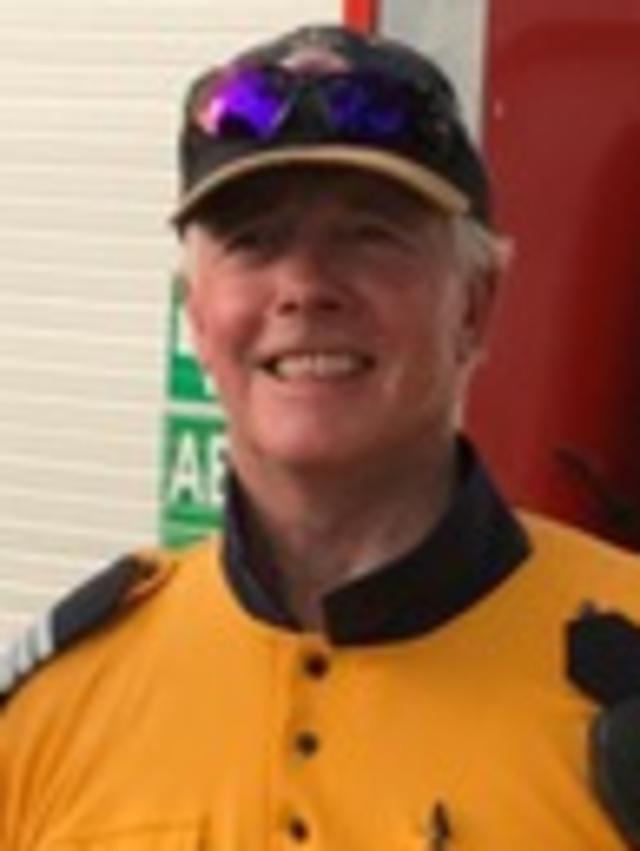
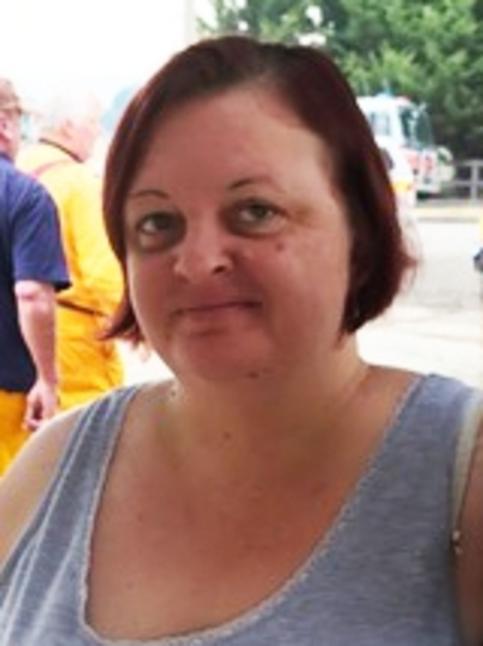
John Sullivan is captain of the Taralga brigade and a great mate. A former army major, Vietnam War veteran, commercial pilot, computing professional, radio technician, carpenter, musician, singer — he’s one of those blokes who’s frustratingly good at whatever he turns his hand to. And he’s the perfect person to have in the eye of Taralga’s fire storm.
John has been out fighting the fire with different crews since it began and although he was able to snare a little sleep last night, the thought of what’s happening out there makes it almost impossible.
“It’s like a war”, John says of the fire. “You try to out-think it, it’s wanting to wipe you out but you just get on with the job.
“At the edge of Bannaby Rd a wall of flame threatened to take out three houses and everyone, the locals holding garden hoses, fought it back. They saved those houses.”
The use of aircraft during this campaign has been phenomenal. The helicopters have been able to obliterate the fires one after the other as they start.
But the most spectacular firefighting weapon has been the enormous DC-10, Nancy Bird, flying at what seems like zero altitude to lay a vast carpet of fire retardant.
John scans the crowd of people working around him and for a moment is overcome. It’s the local community that has affected him most.
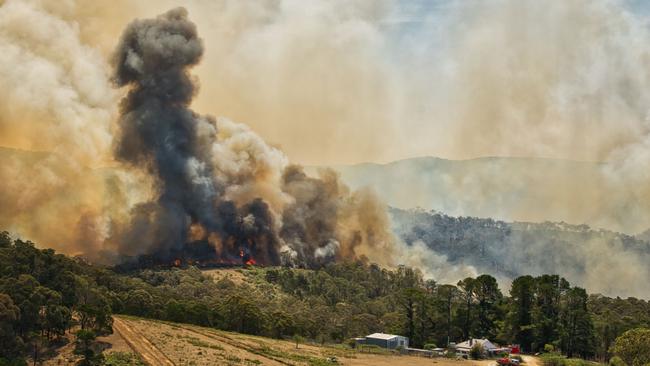
“It’s so humbling,” he says. “Everyone’s been so amazing. People preparing food, making coffee, the Salvation Army — the support has been fantastic.”
For days, local mum Pam Spencer has been managing a line of large eskies filled with ice and bottled water. She went home at midnight last night after a full day and is back again at 7am.
Pam’s a tough country girl — only the other week she posted Facebook photos of a six-foot black snake slithering across her kitchen floor — but like everyone here, she’s been rocked by the fire. “It’s been unbelievably terrifying,” she says. “You could see the fear in the kids’ eyes.”
But this selfless local doesn’t want to talk of her own fears and hardships. Looking me in the eye, she says: “ I want you to send the message out about how fantastic the locals have been — the pubs, the cafes, the general store — the support is unbelievable.”
Indeed, the owners of the Tangled Vine Cafe, Stef and Steve Fitzgerald, have also been working around the clock. When the cafe closes for the day, Steve goes straight to the other end of town to cook for the firefighters. Their cafe has been accepting donations from far and wide.
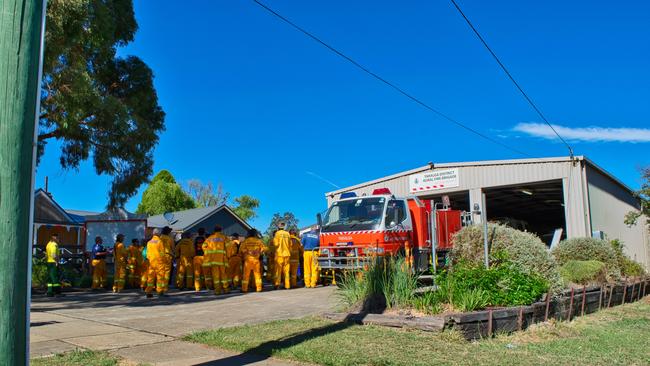
“It’s been a lesson in humanity,” Stef says. “One lady from Sydney rang wanting to donate $2000 and I said ‘We need medical supplies — eyewash, cotton wool’ and I said ‘Ring Blooms the Chemist in Goulburn’ — and she did.”
Other donations have been equally remarkable. “An old lady, a local with not much money, brought in a zip-lock bag with 20 tea bags,” Stef says. “It was her special contribution.”
You can feel the sun gearing up for another punishing day. There is the sound of diesel engines firing up one after another as a convoy of fire trucks peels onto the road, heading north for the battlefield.
The locals wave as the trucks lumber past and the fireys wave back.
Stay safe. Please stay safe ...





